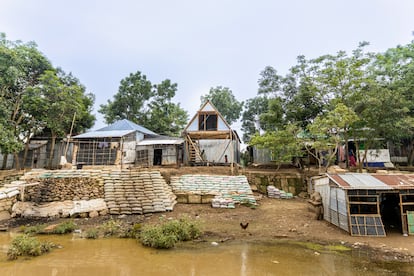Khudi Bari – a model of affordable housing (it costs 500 euros), detachable and easily transportable, double-height (and thus resistant to floods) – means, in Bengali, small house. However, it is not a minor achievement. Although this merit is to improve, just a step, the lives of many people, it implies the possibility of saving them. Its author, the Bangladeshi architect Marina Tabassum (1969) and her team, have designed it to deal with the increasingly frequent floods that – due to climate change – are suffered by her country, a territory defined by the Ganges delta. The Ganges itself and the Barhmaputra river carry enormous quantities of water to the plains, coming from the Himalayas and the neighbouring region of Meghalaya – which concentrates the greatest rainfall on the planet.
Tabassum and his team, in collaboration with representatives of the community that lives in these plains, designed a dwelling with the bare minimum for survival. Thus, a Khudi Bari is a structure made up of triangular elements produced with local materials, such as bamboo, tied together with steel joints. Founded on a square frame buried in the ground – with mud – it has another triangular frame to raise one floor – vital during floods. The sheet metal roof is gabled precisely to deal with the rain. The Kuhi Baris are modular, addable. The lower floors can be left open or paneled. And they are easily dismantled to be easily rebuilt and thus deal with the floods that end up permanently flooding the land.
Tabassum came up with the prototype during the pandemic. And he has been fine-tuning it. His Architecture and Community Equity (FACE) Foundation has already installed more than 100 Khudi Baris and created a control system to allocate them to the most needy population. The simplicity of this construction contrasts with the difficulties of transporting the materials to remote areas by boat or in motorless carts across sandbanks.
Tabassum herself and her team have joined two Khudi Baris to set up their offices next to the Rohingya refugee camp in the Cox’s Bazar district of Bangladesh.
Khudi Bari is about changing a lot with a little. It is also about working with what is at hand. And, of course, about moving from theory to practice when it comes to improving, step by step, the survival of many people. Because of this exemplary desire, the Vitra company has acquired one for the Vitra Campus, where it already coexists with the first building that Frank Gehry built in Europe – the Vitra Design Museum – or the first one that Zaha Hadid managed to build. Prototypes are also on display there, such as the geodesic dome designed by Buckminster Fuller or the gas station designed by Jean Prouvé.

It is just as significant that a building designed for survival should exemplify an architectural achievement as that a place that for decades has exhibited the exemplary architecture of Tadao Ando, Sanaa, Alvaro Siza or Herzog & de Meuron should now also pay attention to tradition and construction with non-industrial materials (Tsuyoshi Tante’s house) or to the wild and moving gardens of Piet Oudolf. This landscaping requires hardly any water. It brings back the picturesque, always unexpected and surprising garden that we have learned to understand as an order that is not imposed but natural. Thus, the architecture and landscaping on display at the Vitra Campus today speak of change, as always, and of technical, formal, humanitarian and sustainable achievements – of the many aspects that make up the best design.

